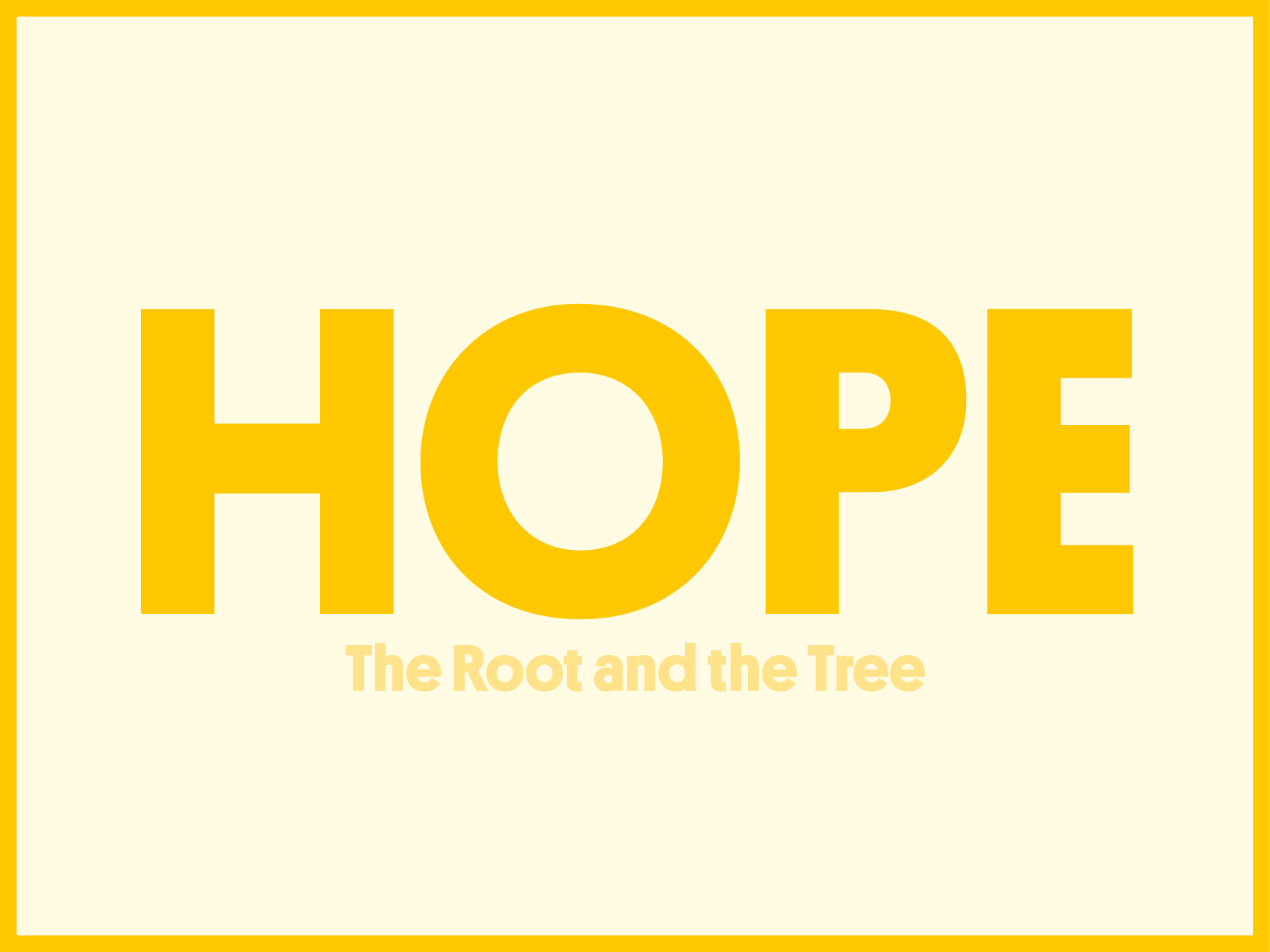Hope: The Root and the Tree
The current social, political, and economic landscape can leave us with enormous despair. We have access to tragedy after tragedy through social media, television, words of mouth, from many across the globe, even while living in the eyes of many storms themselves. What makes this even harder to stomach is the knowledge that a lot of these tragedies are easily preventable. In the last 15 years alone we have seen the climate crisis deepen, continued violence from settler occupation, police brutalising our communities, and the rise of far-right governance and rhetoric globally.
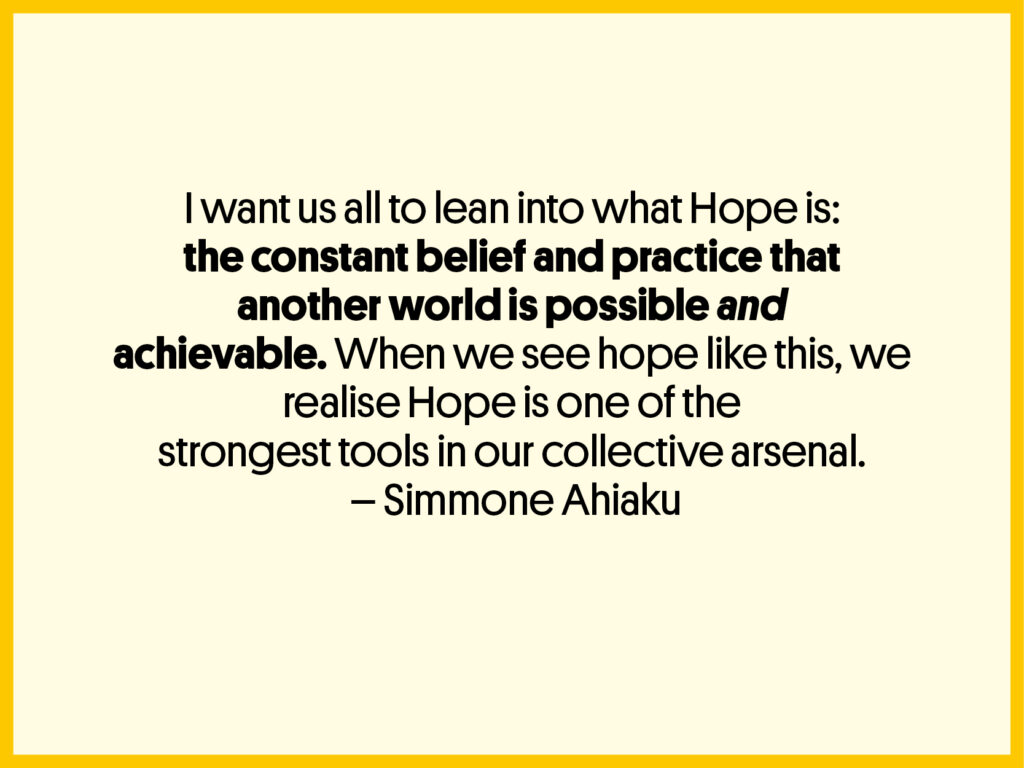
Specifically, in the UK, we have witnessed economic recessions, social and community infrastructure defunded, increasing-price rise in food, transportation, housing, and employment insecurity, mega prisons being built, increased borders control, policing, and state violence. The consistent backdrop in the UK and globally is the constant need for profit-making, control, and exploitation over the wellbeing of people and the planet.
I have experienced hopelessness, burnout, fatigue, grief, anger –often in combination during my years campaigning, but also in just existing and hearing about what’s happening around the world. It’s impossible not to. It’s hard to be hopeful, in a world that constantly proves its futility. This beginning is setting the scene for the general malaise of hopelessness, but will not be the breadth of this article, rather, the springboard for what Hope means in times of a global crisis like this.
Hope is the root that grounds us and the tree that sustains us.
Through my campaigning and activism, I have experienced the highest bouts of hopefulness, creativity, teamwork, and joy about our futures, doing this in community with other people. For many of us, we know that the world as it is currently, does not work for many, and although we have a bank of tested, failed, and successful experiments to look back on from our past, the future is always an unwritten melody- one we hope that we can write and play for ourselves. That is as exciting as it is daunting.
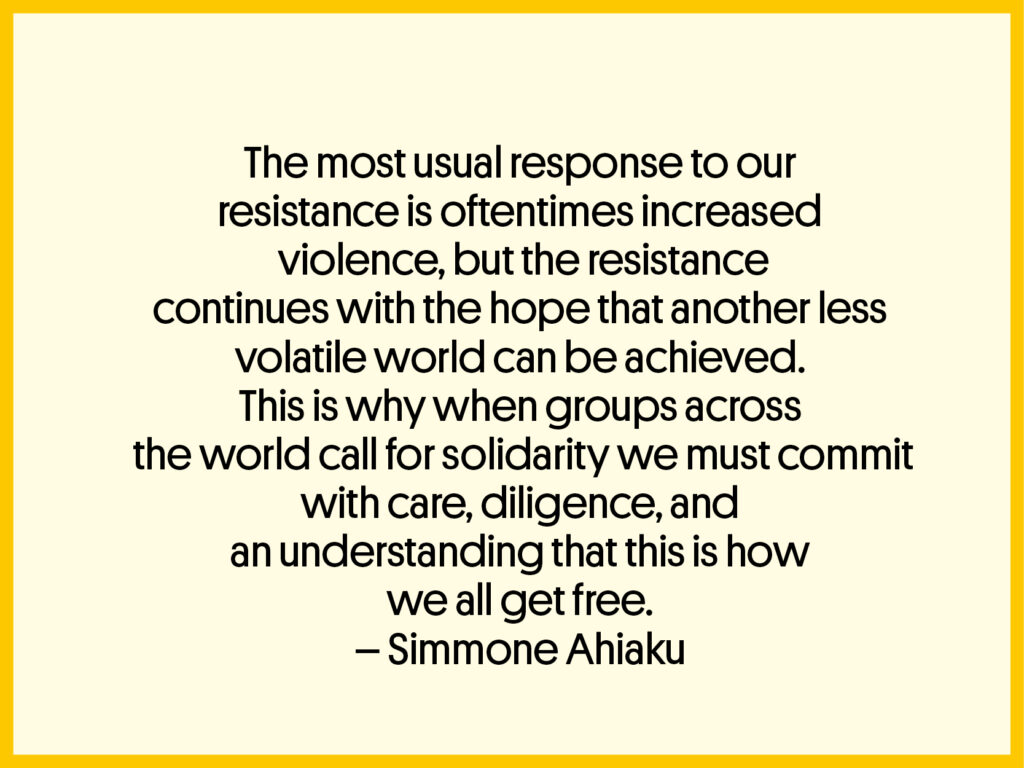
The future is always on the teeter of being the most incredible or devastating scene. While optimism inspires us that all will go well without our efforts, pessimism assumes it’s all irredeemable- in other words, what’s the point of trying? let’s do nothing. Rarely is anything about life, or our futures, so simply cut. To take such a binary stance leaves no room to account for the wins, the mistakes, and importantly the learnings going forward. Relating to activism, existing in a framework like this means that if you don’t succeed straight away, you have failed. This makes many give up or push newcomers away, just when the momentum is building, and victories are within reach. It also shortens the ‘long term game’ in change-making. It ignores the building process of long-standing movements.
I want us to lean into the grey area of optimism and pessimism. The grey area I want us to operate from is Hope. While Hope usually has a positive association, it is also likened to being whimsical, childlike, overly optimistic- living in a fairytale almost. That is not a bad thing, but for some of these, hope is deemed ‘harmless’. It deems what we hope for as rarely achievable- completely beyond reach. It’s something we don’t always prioritise in our lives or movements because other things feel more imminent or useful for that matter.
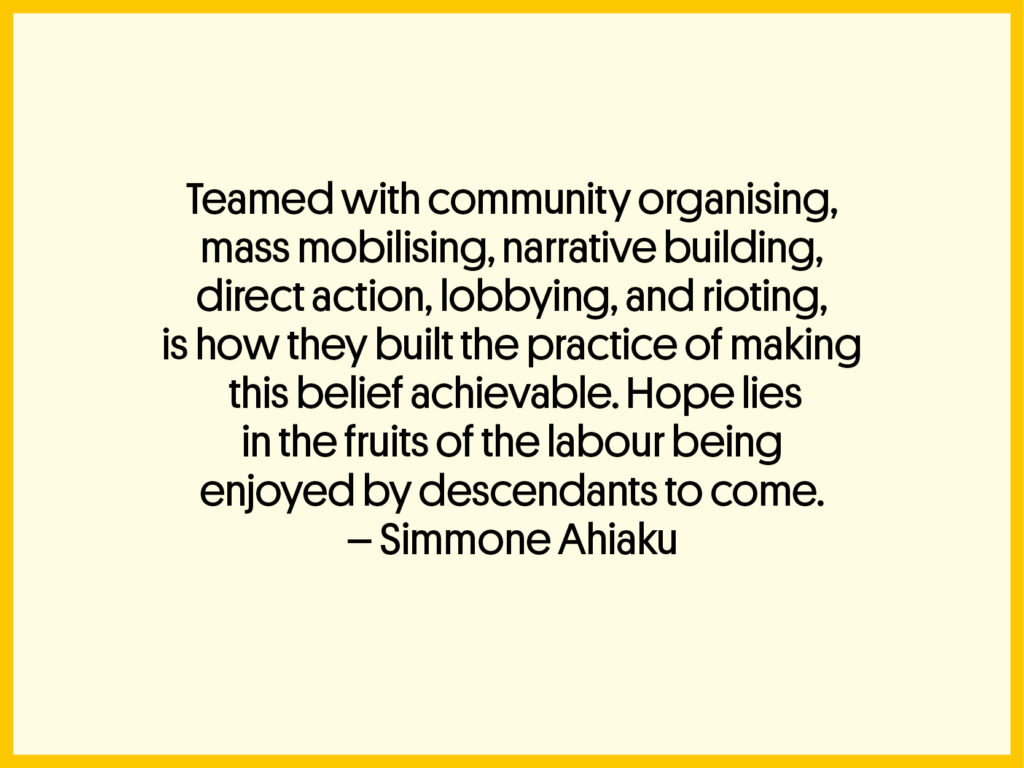
I want us all to lean into what Hope is: the constant belief and practice that another world is possible and achievable. When we see hope like this, we realise Hope is one of the strongest tools in our collective arsenal. It is Hope that pulls us out of slumps to show up day after day and resist. It is Hope that inspires our next crack at a failed attempt- trailing new methods or approaches. It is Hope that inspires our creativity in community and movement building. It is Hope that inspires our imagination of better futures and it is our biggest Hope that one day we will live in the ways we had always dreamed and fought for.
Focusing on our history, the fight for civil rights, The fight for liberation and independence of African nations from imperials powers(specific to the 60-80s in Africa), abolishing of slavery, and ending apartheid in South Africa set out examples of Black people fighting for freedom with the fervor that it will happen and that it may not be in their lifetime. Teamed with community organising, mass mobilising, narrative building, direct action, lobbying, and rioting, is how they built the practice of making this belief achievable. Hope lies in the fruits of the labour being enjoyed by descendants to come.
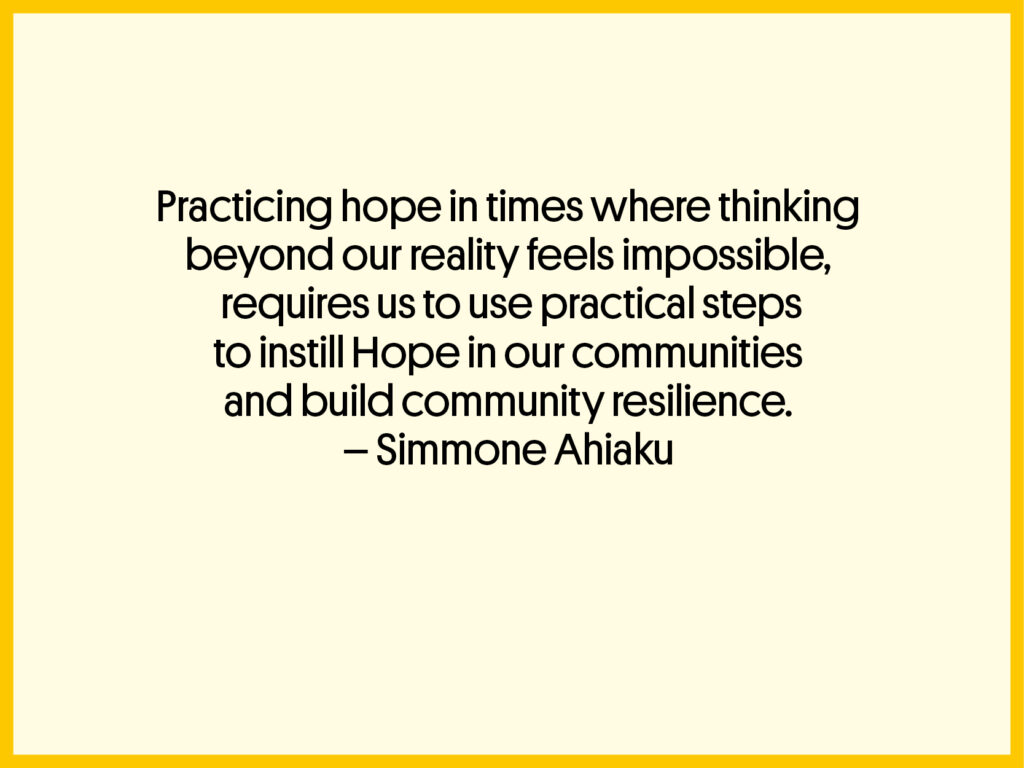
Focusing on the current continued fight for self-determination, Trans liberation, reproductive justice, housing rights, environmental justice, abolishing the global carceral state to name just a few, shows in the abundance of social and environmental movements around the globe.
When the EndSARS movement began in 2020 followed by the devastating Lekki Massacre of October 20, 2020, in Nigeria, we saw the global call for an end to policing not just in Nigeria but across the world, from West Papua to South Africa, to the USA, and to Palestine. We saw conversations about policing expand to the demand of abolishing the police state and ending the occupation of West Papua, Palestine, Western Sahara, and other settler-colonial projects across the globe.
The most usual response to our resistance is oftentimes increased violence, but the resistance continues with the hope that another less volatile world can be achieved. This is why when groups across the world call for solidarity we must commit with care, diligence, and an understanding that this is how we all get free.
Hope is a belief that what we do might matter, an understanding that the future has not come to pass. It’s an informed, critical open-mindedness about what can happen and what role we may play in it. Hope is a continuous motivator that pulls people toward a common goal. Activism cannot exist without Hope. In activism, Hope is crucial for the sustainability of our movements. Though you don’t always have to feel Hope to be motivated to keep fighting for what you believe in, without Hope for what our actions might impact, it would be easy to lapse into apathy and passivity. When the realities of today hold us rigid in despair, Hope gives us the space to dream for a better tomorrow.
Practicing hope in times where thinking beyond our reality feels impossible, requires us to use practical steps to instill Hope in our communities and build community resilience. In Section 6, Chapter 28 of the ‘Spirituality and Community Building guide’. *Some steps they outline are:
- Looking to yours and other movements: This can be practiced in a multitude of ways. Count instances of community resistance done by others as a reason to be hopeful that we can win. See the ways we’ve kept the people alive in this moment when people say we aren’t organised enough, or have the resources, that isn’t totally true.
- Honouring Our Pain: We are all broken because we are living in a world that chooses to break us. We cannot bypass the loss, grief, burnout, pain, and anger that comes through resisting the oppression of any kind. We must hold space for each other and communities and honour those who we have lost and who have gotten us to this point.
- Seeing with New Eyes: In building hope you’re finding out how to work together, how to hold space for each other; so much of our burnout is the feeling, not the doing, how do we nurture ourselves and the collective better.
- Clarifying our next steps to enact change – taking our learnings and recognising the need to be adaptive and flexible with our actions. Not being afraid of failure because you don’t conceptualise it as loss, rather the process of doing something opens you up to doing something better with it or trying a whole new approach
- Hope involves trust: Building trust within our movements and coalitions requires us to show up for other communities as we do for our own, to recognise their fights as ours, and comprehend the ways oppression affects us all.
- It takes a community. While one person can be hopeful, bringing about a hopeful future in your community is a collaborative effort. How do we create spaces where people can say they don’t understand, how do we break down our vision to them, how do we get them on board- while engaging with their knowledge, experiences and questions? Maybe not even bring on board, how do we just create the space for education
- Accepting that Hope and hopelessness can co-exist: Not every day feels like a hopeful one, and even on hopeful days we can hold our sense of hopelessness as dearly. It’s okay for both to be held at the same time
Thinking of Hope as our roots, grounds us in the past, which gives us patterns, models, comparisons, principles, resources, and histories of resilience, brilliance, persistence. It gives us the deep joy to be found in doing the work that liberates us all. Hope as our roots also hold space for our grief, hopelessness, and anger as we mourn continuously. Hope as the tree that sustains us shows us we can seize the possibilities and begin to make Hopes into actualities.
What are your hopes for right now and our collective futures?
How do you think we’ll get there?
* I used the titles In Section 6, Chapter 28 of the ‘Spirituality and Community Building guide for writing this bit on practical steps to hope. These are highlighted words in bold. The text that follows that isn’t in bold are my own words and how I interpret those steps to look like for our movements.


